Person-Centered Care in Aged-Care Facilities
VerifiedAdded on 2020/05/11
|9
|2185
|72
AI Summary
This assignment delves into the concept of person-centered care within aged-care facilities. It examines the impact of this approach on both residents and staff, drawing upon a systematic review of literature to highlight its benefits. The document also explores various interventions and strategies that promote person-centered care in nursing homes, emphasizing best practices for delivering quality care.
Contribute Materials
Your contribution can guide someone’s learning journey. Share your
documents today.

Name_student number_NUR116_TASK_1B
Introduction- Person-centred care is a care-giving plan in which the patient acts as an
equal partner as the one who provides care and the patient helps the caregivers to plan,
develop and monitor his needs. This care plan focuses on the patients and their families
take decisions and develop care plan with the professionals to achieve better outcomes.
Over the past decade, interventions to convert the healthcare and social services to person-
centered plans have become evident. According to Dossey (2012), fusing of these aspects
will help to improve the care quality, make people active in looking after themselves and let
the patients get the care, when they need it.
Medical history- Grace Williams is a 75-year-oldwoman having some health
disorders. She is living in sunshine bay aged care home from past seven months. She was
unable to carry out her daily activities due to emphysema. Her medical history reveals that
she used to be a smoker since she was 25 year old; However, she has quit smoking 6 months
ago to contribute in the oxygen therapy she has been prescribed. She has visited hospitals
multiple times due to Chronic Obstructive Pulmonary Syndrome (COPD). She is also suffering
from Hypertension (HTN) and consumes anti-hypertensive Captopril 6.25mg BD. She
consumes Salbutamol two puffs prn and uses Symbicort inhaler 2 puffs BD to overcome the
COPD. Her latest health reports include high blood pressure (145/82), lowered pulse and
respiration rate, and lowered oxygen consumption rate. Due to these medical conditions,
she should avail person-centred care plan.
Holistic health assessment approach- According to Brownie and Nancarrow (2015),
person centred care plan impacts the quality of care positively. This plan helps the patients
to feel more satisfied and change their experience of care. Moreover, it encourages patient
and their families to be a part of decision-making team including healthcare professionals.
1
Introduction- Person-centred care is a care-giving plan in which the patient acts as an
equal partner as the one who provides care and the patient helps the caregivers to plan,
develop and monitor his needs. This care plan focuses on the patients and their families
take decisions and develop care plan with the professionals to achieve better outcomes.
Over the past decade, interventions to convert the healthcare and social services to person-
centered plans have become evident. According to Dossey (2012), fusing of these aspects
will help to improve the care quality, make people active in looking after themselves and let
the patients get the care, when they need it.
Medical history- Grace Williams is a 75-year-oldwoman having some health
disorders. She is living in sunshine bay aged care home from past seven months. She was
unable to carry out her daily activities due to emphysema. Her medical history reveals that
she used to be a smoker since she was 25 year old; However, she has quit smoking 6 months
ago to contribute in the oxygen therapy she has been prescribed. She has visited hospitals
multiple times due to Chronic Obstructive Pulmonary Syndrome (COPD). She is also suffering
from Hypertension (HTN) and consumes anti-hypertensive Captopril 6.25mg BD. She
consumes Salbutamol two puffs prn and uses Symbicort inhaler 2 puffs BD to overcome the
COPD. Her latest health reports include high blood pressure (145/82), lowered pulse and
respiration rate, and lowered oxygen consumption rate. Due to these medical conditions,
she should avail person-centred care plan.
Holistic health assessment approach- According to Brownie and Nancarrow (2015),
person centred care plan impacts the quality of care positively. This plan helps the patients
to feel more satisfied and change their experience of care. Moreover, it encourages patient
and their families to be a part of decision-making team including healthcare professionals.
1
Secure Best Marks with AI Grader
Need help grading? Try our AI Grader for instant feedback on your assignments.
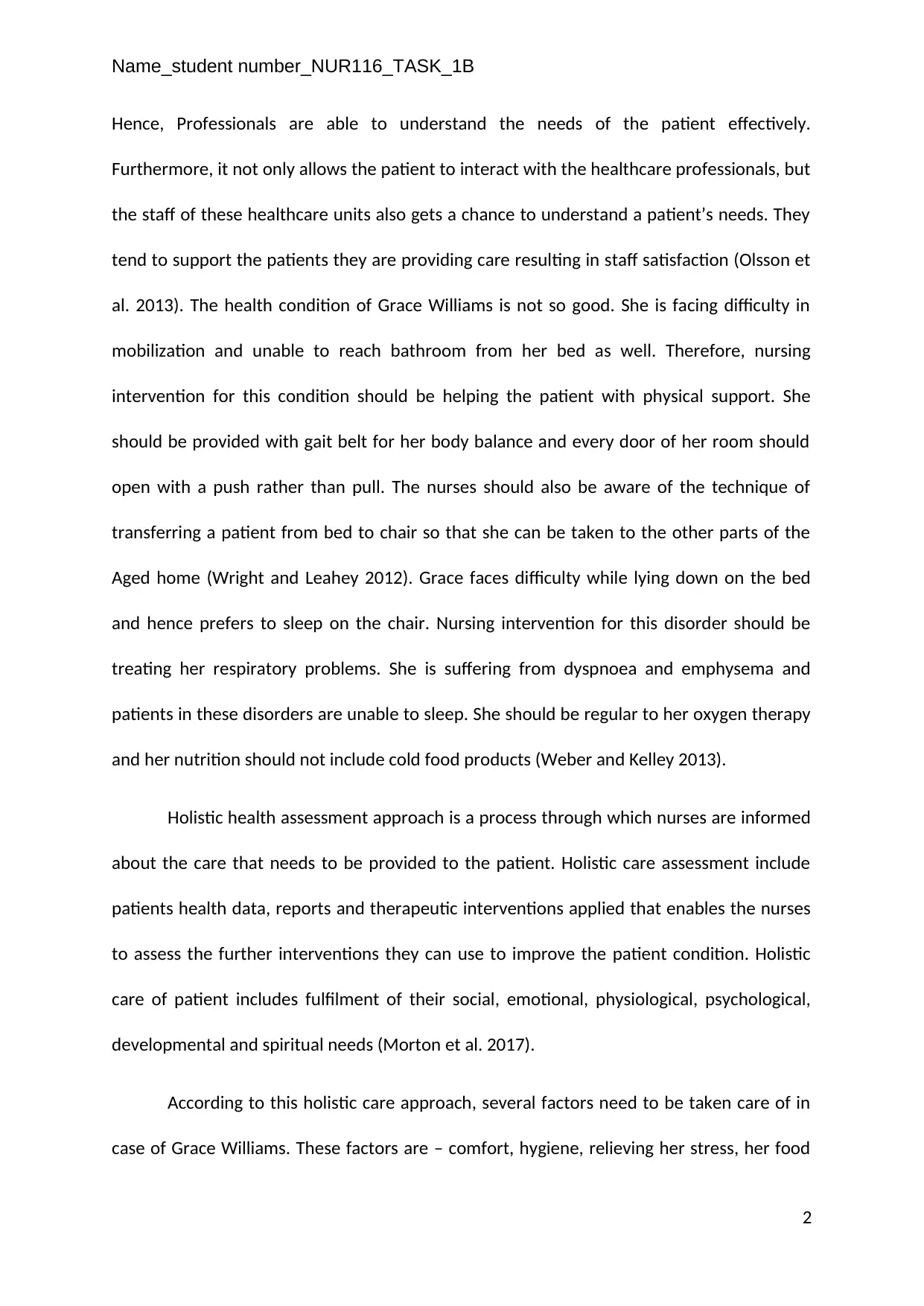
Name_student number_NUR116_TASK_1B
Hence, Professionals are able to understand the needs of the patient effectively.
Furthermore, it not only allows the patient to interact with the healthcare professionals, but
the staff of these healthcare units also gets a chance to understand a patient’s needs. They
tend to support the patients they are providing care resulting in staff satisfaction (Olsson et
al. 2013). The health condition of Grace Williams is not so good. She is facing difficulty in
mobilization and unable to reach bathroom from her bed as well. Therefore, nursing
intervention for this condition should be helping the patient with physical support. She
should be provided with gait belt for her body balance and every door of her room should
open with a push rather than pull. The nurses should also be aware of the technique of
transferring a patient from bed to chair so that she can be taken to the other parts of the
Aged home (Wright and Leahey 2012). Grace faces difficulty while lying down on the bed
and hence prefers to sleep on the chair. Nursing intervention for this disorder should be
treating her respiratory problems. She is suffering from dyspnoea and emphysema and
patients in these disorders are unable to sleep. She should be regular to her oxygen therapy
and her nutrition should not include cold food products (Weber and Kelley 2013).
Holistic health assessment approach is a process through which nurses are informed
about the care that needs to be provided to the patient. Holistic care assessment include
patients health data, reports and therapeutic interventions applied that enables the nurses
to assess the further interventions they can use to improve the patient condition. Holistic
care of patient includes fulfilment of their social, emotional, physiological, psychological,
developmental and spiritual needs (Morton et al. 2017).
According to this holistic care approach, several factors need to be taken care of in
case of Grace Williams. These factors are – comfort, hygiene, relieving her stress, her food
2
Hence, Professionals are able to understand the needs of the patient effectively.
Furthermore, it not only allows the patient to interact with the healthcare professionals, but
the staff of these healthcare units also gets a chance to understand a patient’s needs. They
tend to support the patients they are providing care resulting in staff satisfaction (Olsson et
al. 2013). The health condition of Grace Williams is not so good. She is facing difficulty in
mobilization and unable to reach bathroom from her bed as well. Therefore, nursing
intervention for this condition should be helping the patient with physical support. She
should be provided with gait belt for her body balance and every door of her room should
open with a push rather than pull. The nurses should also be aware of the technique of
transferring a patient from bed to chair so that she can be taken to the other parts of the
Aged home (Wright and Leahey 2012). Grace faces difficulty while lying down on the bed
and hence prefers to sleep on the chair. Nursing intervention for this disorder should be
treating her respiratory problems. She is suffering from dyspnoea and emphysema and
patients in these disorders are unable to sleep. She should be regular to her oxygen therapy
and her nutrition should not include cold food products (Weber and Kelley 2013).
Holistic health assessment approach is a process through which nurses are informed
about the care that needs to be provided to the patient. Holistic care assessment include
patients health data, reports and therapeutic interventions applied that enables the nurses
to assess the further interventions they can use to improve the patient condition. Holistic
care of patient includes fulfilment of their social, emotional, physiological, psychological,
developmental and spiritual needs (Morton et al. 2017).
According to this holistic care approach, several factors need to be taken care of in
case of Grace Williams. These factors are – comfort, hygiene, relieving her stress, her food
2
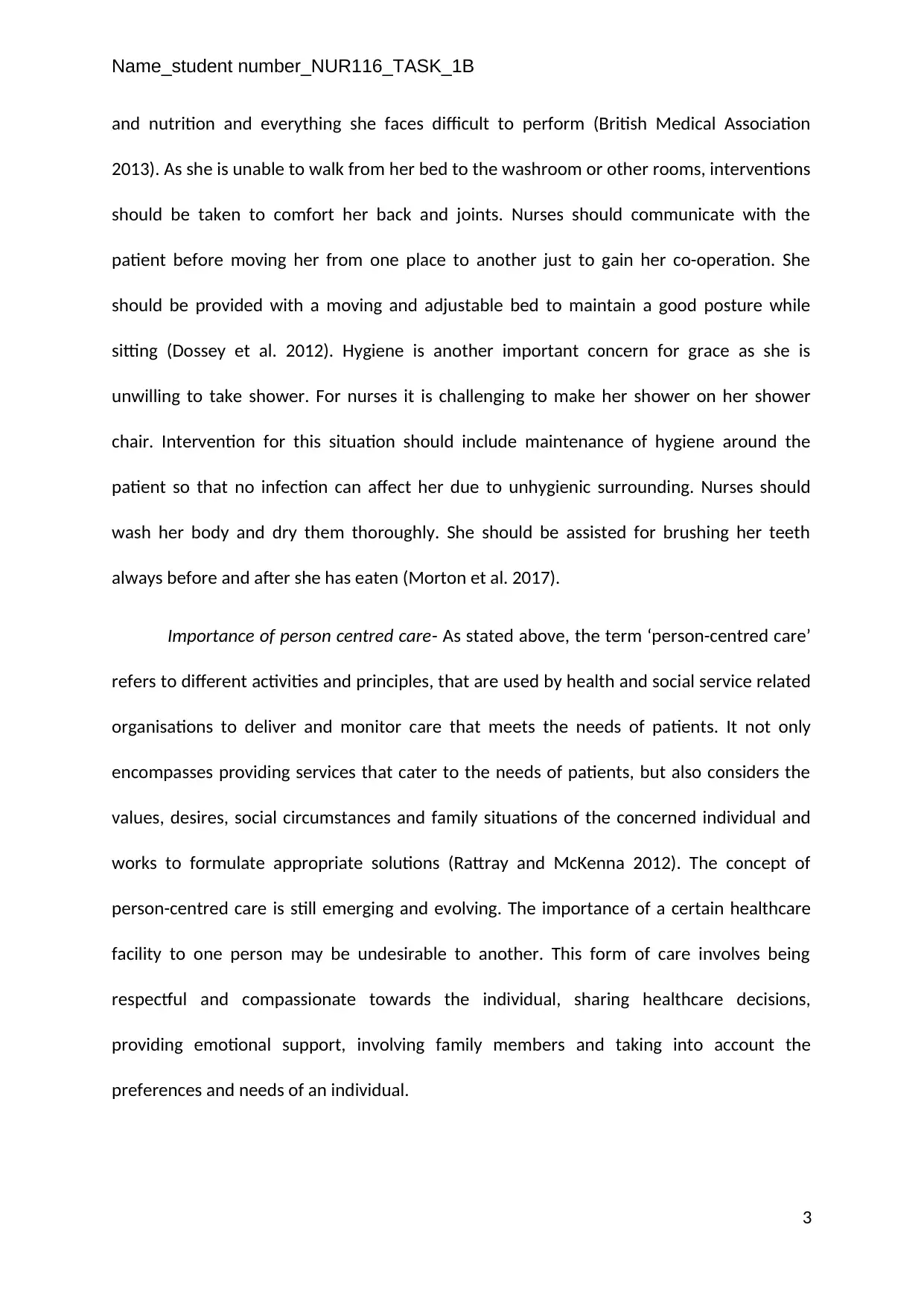
Name_student number_NUR116_TASK_1B
and nutrition and everything she faces difficult to perform (British Medical Association
2013). As she is unable to walk from her bed to the washroom or other rooms, interventions
should be taken to comfort her back and joints. Nurses should communicate with the
patient before moving her from one place to another just to gain her co-operation. She
should be provided with a moving and adjustable bed to maintain a good posture while
sitting (Dossey et al. 2012). Hygiene is another important concern for grace as she is
unwilling to take shower. For nurses it is challenging to make her shower on her shower
chair. Intervention for this situation should include maintenance of hygiene around the
patient so that no infection can affect her due to unhygienic surrounding. Nurses should
wash her body and dry them thoroughly. She should be assisted for brushing her teeth
always before and after she has eaten (Morton et al. 2017).
Importance of person centred care- As stated above, the term ‘person-centred care’
refers to different activities and principles, that are used by health and social service related
organisations to deliver and monitor care that meets the needs of patients. It not only
encompasses providing services that cater to the needs of patients, but also considers the
values, desires, social circumstances and family situations of the concerned individual and
works to formulate appropriate solutions (Rattray and McKenna 2012). The concept of
person-centred care is still emerging and evolving. The importance of a certain healthcare
facility to one person may be undesirable to another. This form of care involves being
respectful and compassionate towards the individual, sharing healthcare decisions,
providing emotional support, involving family members and taking into account the
preferences and needs of an individual.
3
and nutrition and everything she faces difficult to perform (British Medical Association
2013). As she is unable to walk from her bed to the washroom or other rooms, interventions
should be taken to comfort her back and joints. Nurses should communicate with the
patient before moving her from one place to another just to gain her co-operation. She
should be provided with a moving and adjustable bed to maintain a good posture while
sitting (Dossey et al. 2012). Hygiene is another important concern for grace as she is
unwilling to take shower. For nurses it is challenging to make her shower on her shower
chair. Intervention for this situation should include maintenance of hygiene around the
patient so that no infection can affect her due to unhygienic surrounding. Nurses should
wash her body and dry them thoroughly. She should be assisted for brushing her teeth
always before and after she has eaten (Morton et al. 2017).
Importance of person centred care- As stated above, the term ‘person-centred care’
refers to different activities and principles, that are used by health and social service related
organisations to deliver and monitor care that meets the needs of patients. It not only
encompasses providing services that cater to the needs of patients, but also considers the
values, desires, social circumstances and family situations of the concerned individual and
works to formulate appropriate solutions (Rattray and McKenna 2012). The concept of
person-centred care is still emerging and evolving. The importance of a certain healthcare
facility to one person may be undesirable to another. This form of care involves being
respectful and compassionate towards the individual, sharing healthcare decisions,
providing emotional support, involving family members and taking into account the
preferences and needs of an individual.
3
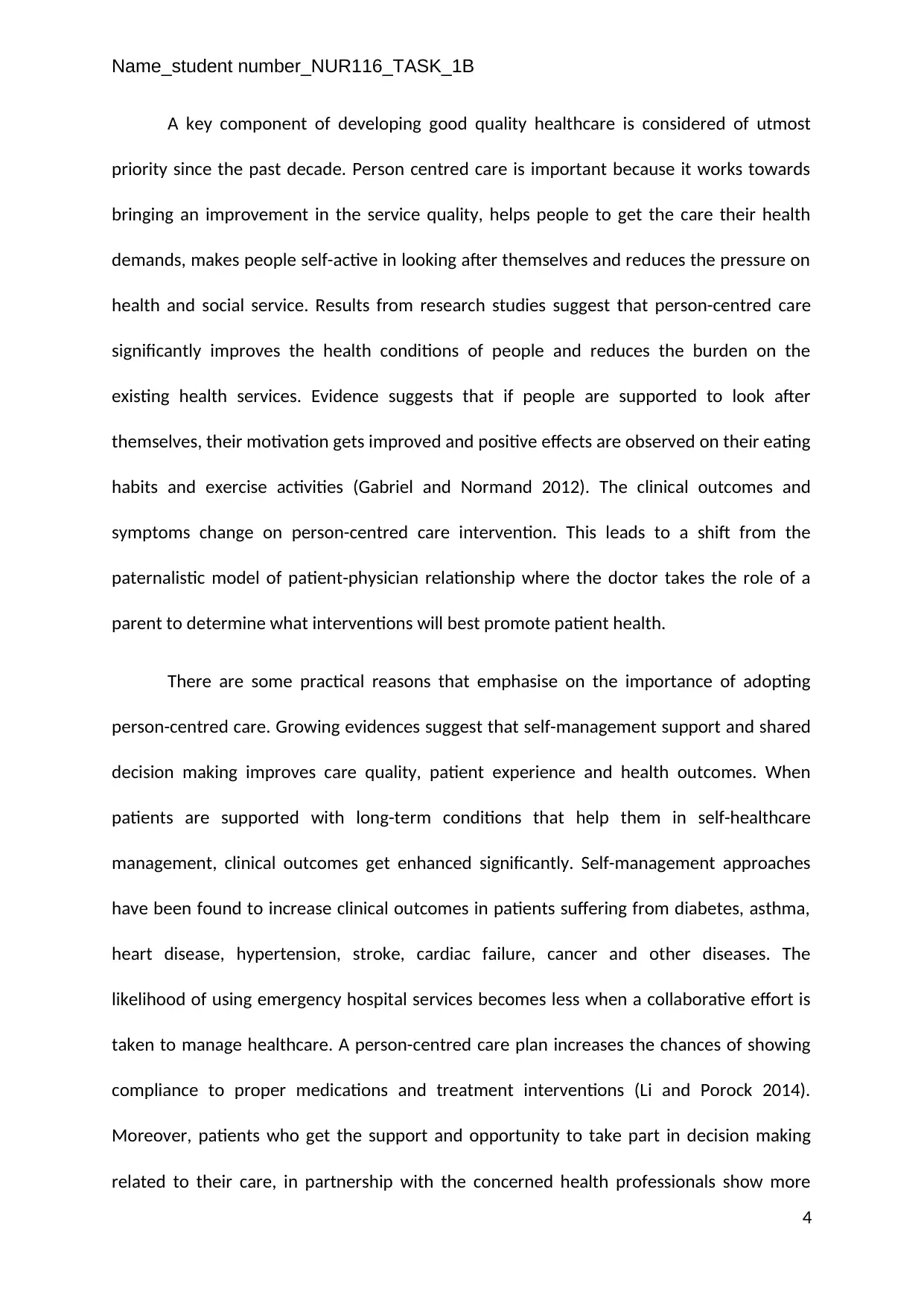
Name_student number_NUR116_TASK_1B
A key component of developing good quality healthcare is considered of utmost
priority since the past decade. Person centred care is important because it works towards
bringing an improvement in the service quality, helps people to get the care their health
demands, makes people self-active in looking after themselves and reduces the pressure on
health and social service. Results from research studies suggest that person-centred care
significantly improves the health conditions of people and reduces the burden on the
existing health services. Evidence suggests that if people are supported to look after
themselves, their motivation gets improved and positive effects are observed on their eating
habits and exercise activities (Gabriel and Normand 2012). The clinical outcomes and
symptoms change on person-centred care intervention. This leads to a shift from the
paternalistic model of patient-physician relationship where the doctor takes the role of a
parent to determine what interventions will best promote patient health.
There are some practical reasons that emphasise on the importance of adopting
person-centred care. Growing evidences suggest that self-management support and shared
decision making improves care quality, patient experience and health outcomes. When
patients are supported with long-term conditions that help them in self-healthcare
management, clinical outcomes get enhanced significantly. Self-management approaches
have been found to increase clinical outcomes in patients suffering from diabetes, asthma,
heart disease, hypertension, stroke, cardiac failure, cancer and other diseases. The
likelihood of using emergency hospital services becomes less when a collaborative effort is
taken to manage healthcare. A person-centred care plan increases the chances of showing
compliance to proper medications and treatment interventions (Li and Porock 2014).
Moreover, patients who get the support and opportunity to take part in decision making
related to their care, in partnership with the concerned health professionals show more
4
A key component of developing good quality healthcare is considered of utmost
priority since the past decade. Person centred care is important because it works towards
bringing an improvement in the service quality, helps people to get the care their health
demands, makes people self-active in looking after themselves and reduces the pressure on
health and social service. Results from research studies suggest that person-centred care
significantly improves the health conditions of people and reduces the burden on the
existing health services. Evidence suggests that if people are supported to look after
themselves, their motivation gets improved and positive effects are observed on their eating
habits and exercise activities (Gabriel and Normand 2012). The clinical outcomes and
symptoms change on person-centred care intervention. This leads to a shift from the
paternalistic model of patient-physician relationship where the doctor takes the role of a
parent to determine what interventions will best promote patient health.
There are some practical reasons that emphasise on the importance of adopting
person-centred care. Growing evidences suggest that self-management support and shared
decision making improves care quality, patient experience and health outcomes. When
patients are supported with long-term conditions that help them in self-healthcare
management, clinical outcomes get enhanced significantly. Self-management approaches
have been found to increase clinical outcomes in patients suffering from diabetes, asthma,
heart disease, hypertension, stroke, cardiac failure, cancer and other diseases. The
likelihood of using emergency hospital services becomes less when a collaborative effort is
taken to manage healthcare. A person-centred care plan increases the chances of showing
compliance to proper medications and treatment interventions (Li and Porock 2014).
Moreover, patients who get the support and opportunity to take part in decision making
related to their care, in partnership with the concerned health professionals show more
4
Secure Best Marks with AI Grader
Need help grading? Try our AI Grader for instant feedback on your assignments.
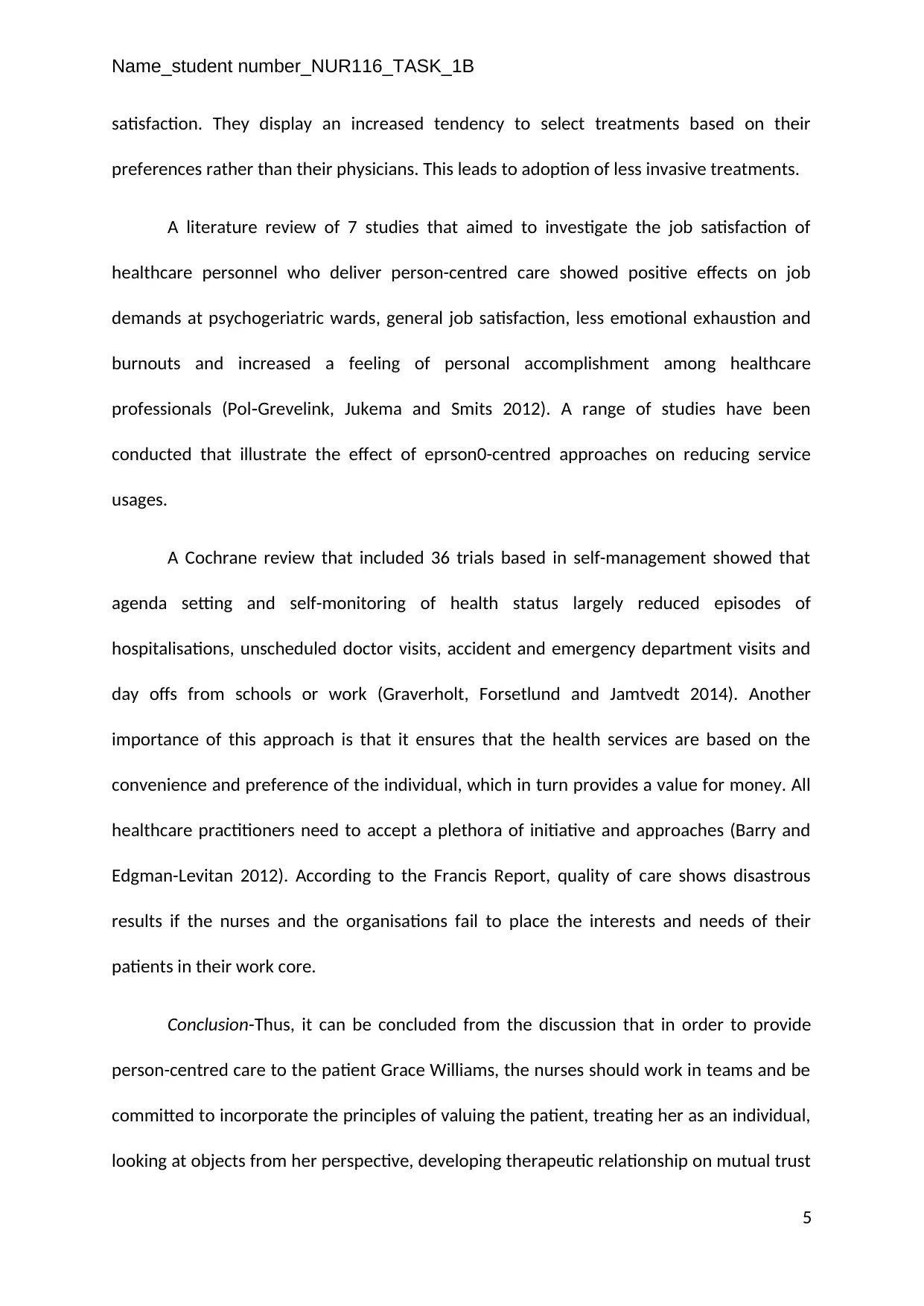
Name_student number_NUR116_TASK_1B
satisfaction. They display an increased tendency to select treatments based on their
preferences rather than their physicians. This leads to adoption of less invasive treatments.
A literature review of 7 studies that aimed to investigate the job satisfaction of
healthcare personnel who deliver person-centred care showed positive effects on job
demands at psychogeriatric wards, general job satisfaction, less emotional exhaustion and
burnouts and increased a feeling of personal accomplishment among healthcare
professionals (Pol Grevelink, Jukema and Smits 2012). A range of studies have been‐
conducted that illustrate the effect of eprson0-centred approaches on reducing service
usages.
A Cochrane review that included 36 trials based in self-management showed that
agenda setting and self-monitoring of health status largely reduced episodes of
hospitalisations, unscheduled doctor visits, accident and emergency department visits and
day offs from schools or work (Graverholt, Forsetlund and Jamtvedt 2014). Another
importance of this approach is that it ensures that the health services are based on the
convenience and preference of the individual, which in turn provides a value for money. All
healthcare practitioners need to accept a plethora of initiative and approaches (Barry and
Edgman-Levitan 2012). According to the Francis Report, quality of care shows disastrous
results if the nurses and the organisations fail to place the interests and needs of their
patients in their work core.
Conclusion-Thus, it can be concluded from the discussion that in order to provide
person-centred care to the patient Grace Williams, the nurses should work in teams and be
committed to incorporate the principles of valuing the patient, treating her as an individual,
looking at objects from her perspective, developing therapeutic relationship on mutual trust
5
satisfaction. They display an increased tendency to select treatments based on their
preferences rather than their physicians. This leads to adoption of less invasive treatments.
A literature review of 7 studies that aimed to investigate the job satisfaction of
healthcare personnel who deliver person-centred care showed positive effects on job
demands at psychogeriatric wards, general job satisfaction, less emotional exhaustion and
burnouts and increased a feeling of personal accomplishment among healthcare
professionals (Pol Grevelink, Jukema and Smits 2012). A range of studies have been‐
conducted that illustrate the effect of eprson0-centred approaches on reducing service
usages.
A Cochrane review that included 36 trials based in self-management showed that
agenda setting and self-monitoring of health status largely reduced episodes of
hospitalisations, unscheduled doctor visits, accident and emergency department visits and
day offs from schools or work (Graverholt, Forsetlund and Jamtvedt 2014). Another
importance of this approach is that it ensures that the health services are based on the
convenience and preference of the individual, which in turn provides a value for money. All
healthcare practitioners need to accept a plethora of initiative and approaches (Barry and
Edgman-Levitan 2012). According to the Francis Report, quality of care shows disastrous
results if the nurses and the organisations fail to place the interests and needs of their
patients in their work core.
Conclusion-Thus, it can be concluded from the discussion that in order to provide
person-centred care to the patient Grace Williams, the nurses should work in teams and be
committed to incorporate the principles of valuing the patient, treating her as an individual,
looking at objects from her perspective, developing therapeutic relationship on mutual trust
5
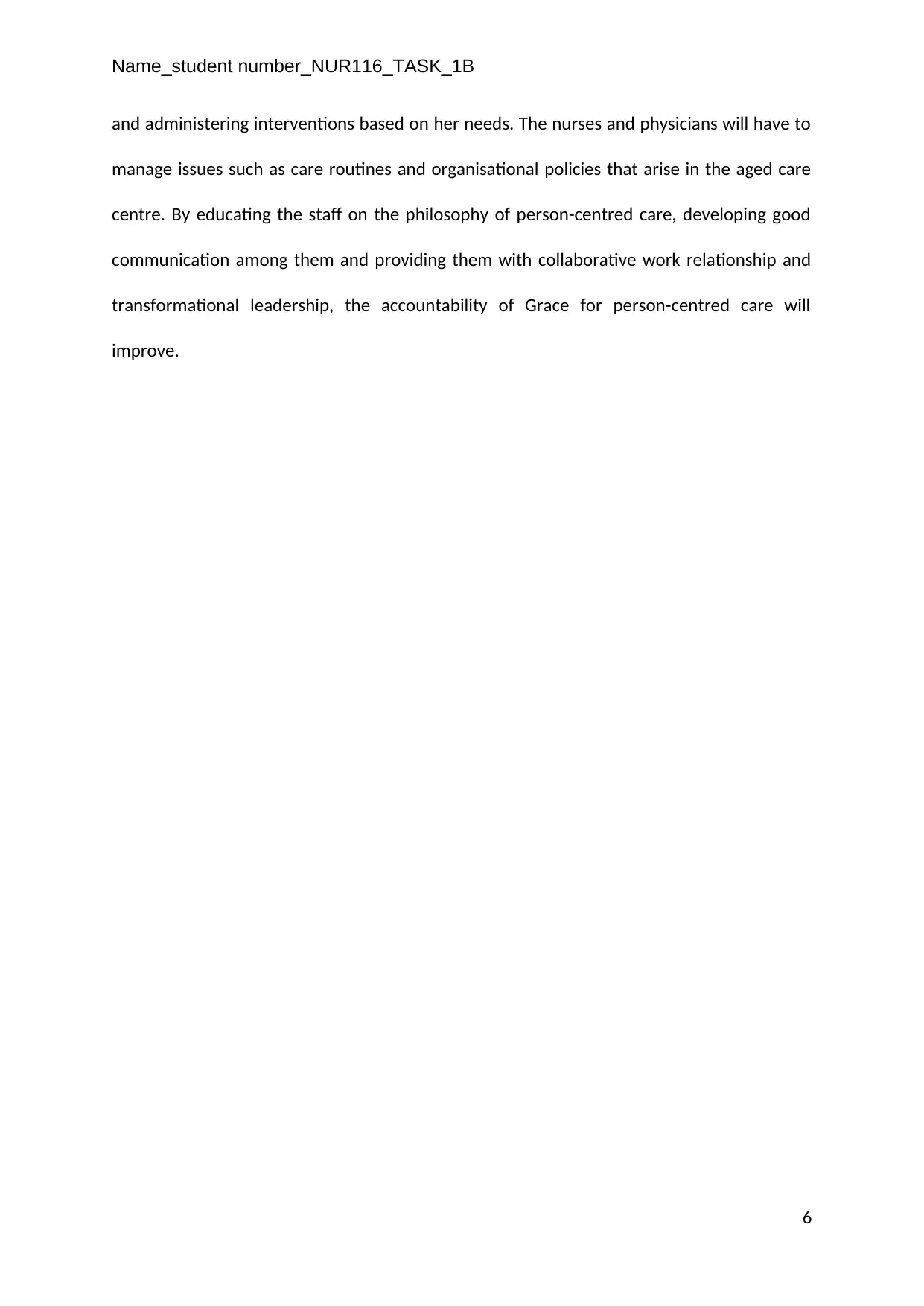
Name_student number_NUR116_TASK_1B
and administering interventions based on her needs. The nurses and physicians will have to
manage issues such as care routines and organisational policies that arise in the aged care
centre. By educating the staff on the philosophy of person-centred care, developing good
communication among them and providing them with collaborative work relationship and
transformational leadership, the accountability of Grace for person-centred care will
improve.
6
and administering interventions based on her needs. The nurses and physicians will have to
manage issues such as care routines and organisational policies that arise in the aged care
centre. By educating the staff on the philosophy of person-centred care, developing good
communication among them and providing them with collaborative work relationship and
transformational leadership, the accountability of Grace for person-centred care will
improve.
6
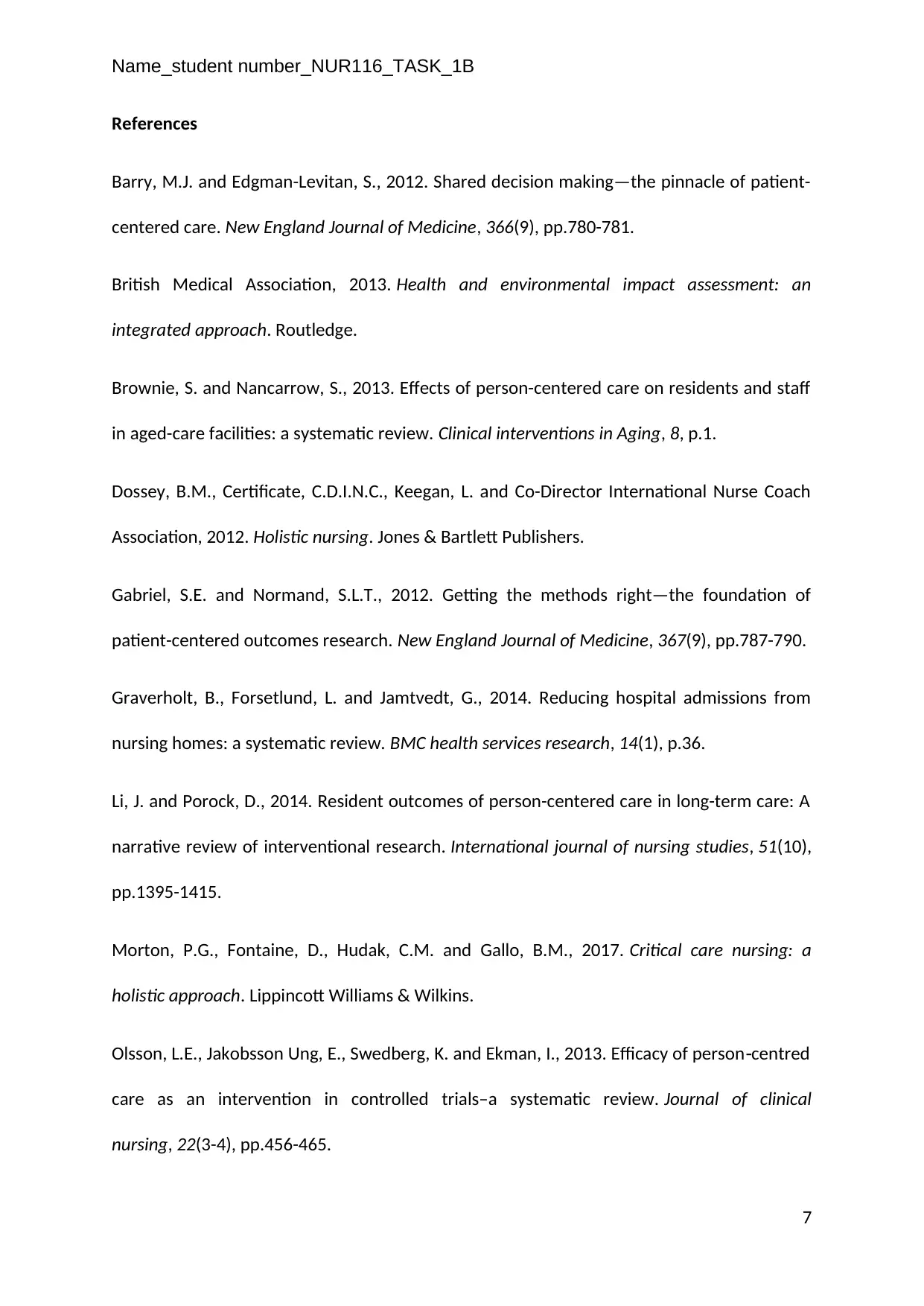
Name_student number_NUR116_TASK_1B
References
Barry, M.J. and Edgman-Levitan, S., 2012. Shared decision making—the pinnacle of patient-
centered care. New England Journal of Medicine, 366(9), pp.780-781.
British Medical Association, 2013. Health and environmental impact assessment: an
integrated approach. Routledge.
Brownie, S. and Nancarrow, S., 2013. Effects of person-centered care on residents and staff
in aged-care facilities: a systematic review. Clinical interventions in Aging, 8, p.1.
Dossey, B.M., Certificate, C.D.I.N.C., Keegan, L. and Co-Director International Nurse Coach
Association, 2012. Holistic nursing. Jones & Bartlett Publishers.
Gabriel, S.E. and Normand, S.L.T., 2012. Getting the methods right—the foundation of
patient-centered outcomes research. New England Journal of Medicine, 367(9), pp.787-790.
Graverholt, B., Forsetlund, L. and Jamtvedt, G., 2014. Reducing hospital admissions from
nursing homes: a systematic review. BMC health services research, 14(1), p.36.
Li, J. and Porock, D., 2014. Resident outcomes of person-centered care in long-term care: A
narrative review of interventional research. International journal of nursing studies, 51(10),
pp.1395-1415.
Morton, P.G., Fontaine, D., Hudak, C.M. and Gallo, B.M., 2017. Critical care nursing: a
holistic approach. Lippincott Williams & Wilkins.
Olsson, L.E., Jakobsson Ung, E., Swedberg, K. and Ekman, I., 2013. Efficacy of person centred‐
care as an intervention in controlled trials–a systematic review. Journal of clinical
nursing, 22(3-4), pp.456-465.
7
References
Barry, M.J. and Edgman-Levitan, S., 2012. Shared decision making—the pinnacle of patient-
centered care. New England Journal of Medicine, 366(9), pp.780-781.
British Medical Association, 2013. Health and environmental impact assessment: an
integrated approach. Routledge.
Brownie, S. and Nancarrow, S., 2013. Effects of person-centered care on residents and staff
in aged-care facilities: a systematic review. Clinical interventions in Aging, 8, p.1.
Dossey, B.M., Certificate, C.D.I.N.C., Keegan, L. and Co-Director International Nurse Coach
Association, 2012. Holistic nursing. Jones & Bartlett Publishers.
Gabriel, S.E. and Normand, S.L.T., 2012. Getting the methods right—the foundation of
patient-centered outcomes research. New England Journal of Medicine, 367(9), pp.787-790.
Graverholt, B., Forsetlund, L. and Jamtvedt, G., 2014. Reducing hospital admissions from
nursing homes: a systematic review. BMC health services research, 14(1), p.36.
Li, J. and Porock, D., 2014. Resident outcomes of person-centered care in long-term care: A
narrative review of interventional research. International journal of nursing studies, 51(10),
pp.1395-1415.
Morton, P.G., Fontaine, D., Hudak, C.M. and Gallo, B.M., 2017. Critical care nursing: a
holistic approach. Lippincott Williams & Wilkins.
Olsson, L.E., Jakobsson Ung, E., Swedberg, K. and Ekman, I., 2013. Efficacy of person centred‐
care as an intervention in controlled trials–a systematic review. Journal of clinical
nursing, 22(3-4), pp.456-465.
7
Paraphrase This Document
Need a fresh take? Get an instant paraphrase of this document with our AI Paraphraser
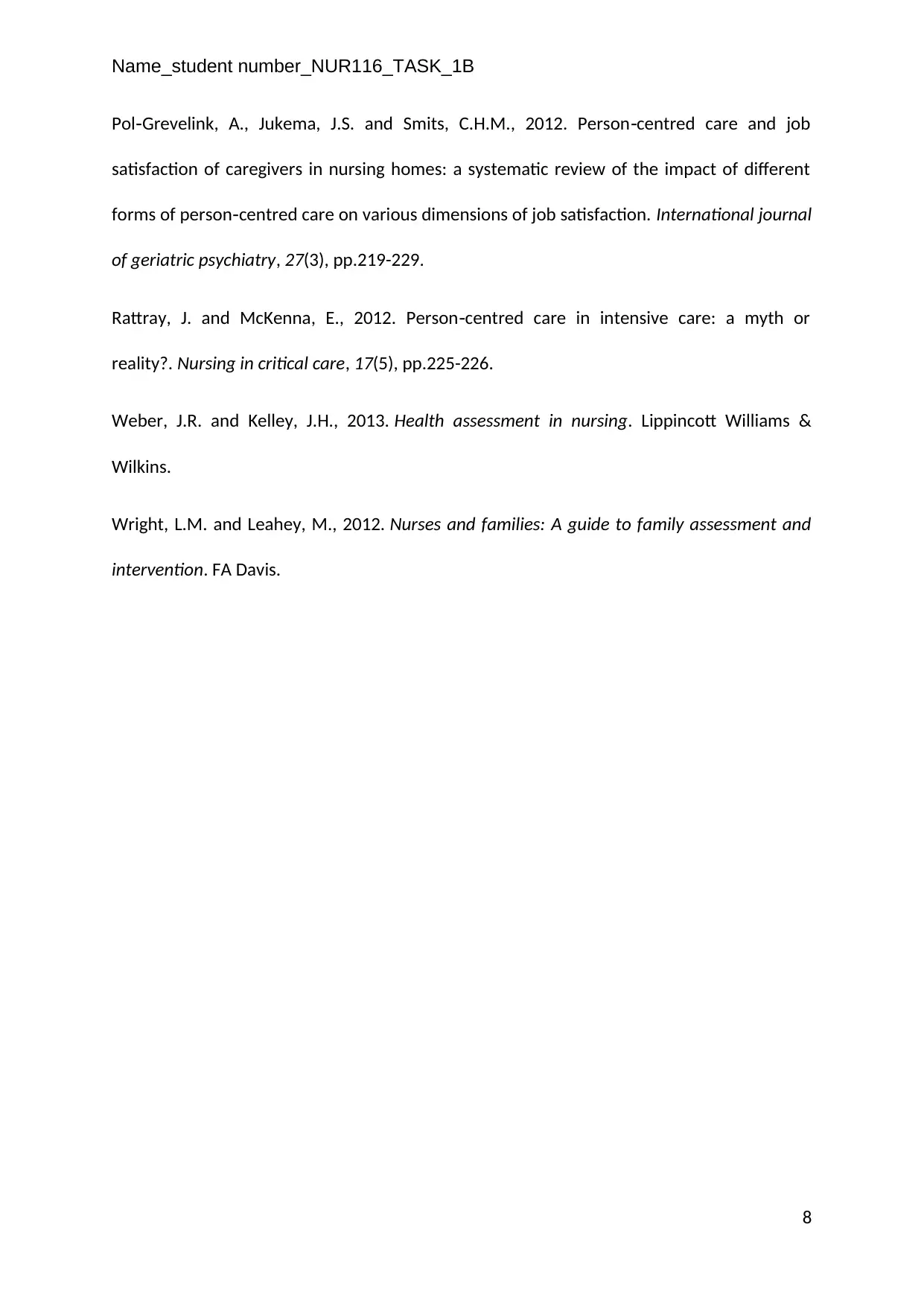
Name_student number_NUR116_TASK_1B
Pol Grevelink, A., Jukema, J.S. and Smits, C.H.M., 2012. Person centred care and job‐ ‐
satisfaction of caregivers in nursing homes: a systematic review of the impact of different
forms of person centred care on various dimensions of job satisfaction.‐ International journal
of geriatric psychiatry, 27(3), pp.219-229.
Rattray, J. and McKenna, E., 2012. Person centred care in intensive care: a myth or‐
reality?. Nursing in critical care, 17(5), pp.225-226.
Weber, J.R. and Kelley, J.H., 2013. Health assessment in nursing. Lippincott Williams &
Wilkins.
Wright, L.M. and Leahey, M., 2012. Nurses and families: A guide to family assessment and
intervention. FA Davis.
8
Pol Grevelink, A., Jukema, J.S. and Smits, C.H.M., 2012. Person centred care and job‐ ‐
satisfaction of caregivers in nursing homes: a systematic review of the impact of different
forms of person centred care on various dimensions of job satisfaction.‐ International journal
of geriatric psychiatry, 27(3), pp.219-229.
Rattray, J. and McKenna, E., 2012. Person centred care in intensive care: a myth or‐
reality?. Nursing in critical care, 17(5), pp.225-226.
Weber, J.R. and Kelley, J.H., 2013. Health assessment in nursing. Lippincott Williams &
Wilkins.
Wright, L.M. and Leahey, M., 2012. Nurses and families: A guide to family assessment and
intervention. FA Davis.
8
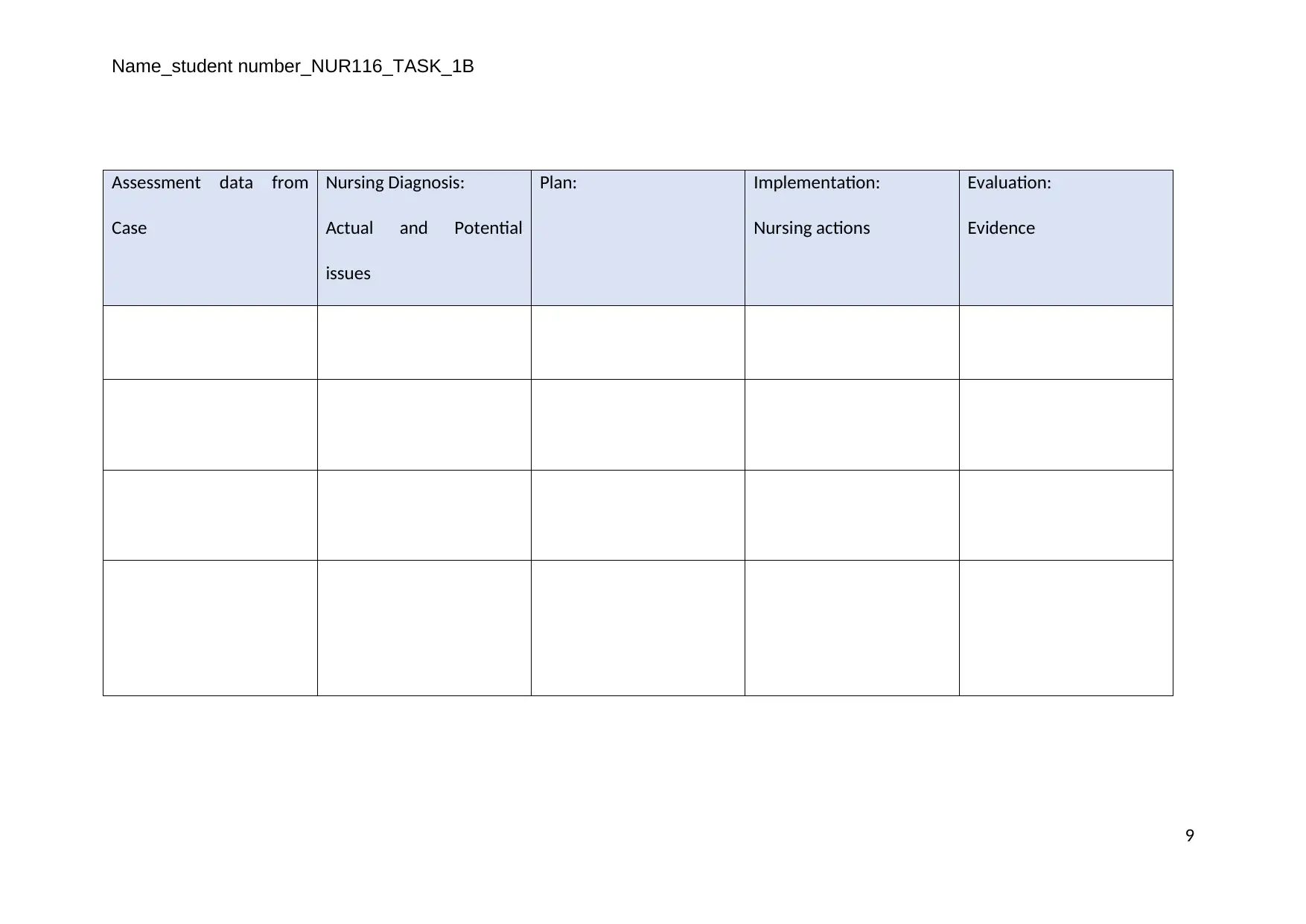
Name_student number_NUR116_TASK_1B
Assessment data from
Case
Nursing Diagnosis:
Actual and Potential
issues
Plan: Implementation:
Nursing actions
Evaluation:
Evidence
9
Assessment data from
Case
Nursing Diagnosis:
Actual and Potential
issues
Plan: Implementation:
Nursing actions
Evaluation:
Evidence
9
1 out of 9
Related Documents
Your All-in-One AI-Powered Toolkit for Academic Success.
+13062052269
info@desklib.com
Available 24*7 on WhatsApp / Email
![[object Object]](/_next/static/media/star-bottom.7253800d.svg)
Unlock your academic potential
© 2024 | Zucol Services PVT LTD | All rights reserved.





